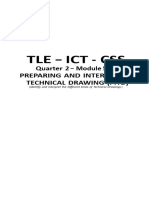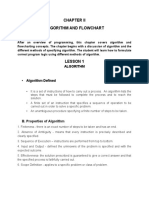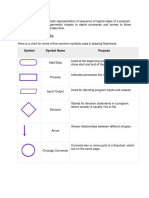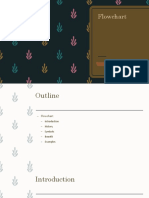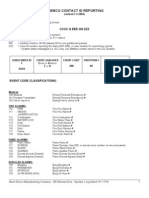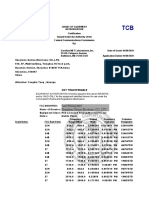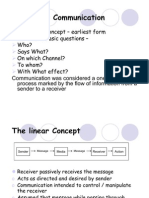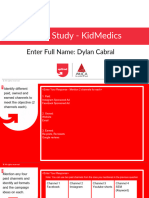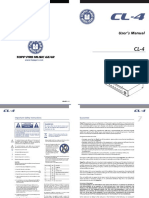What are Flowcharts?
Flowcharts are the visual representations of an algorithm or a process. Flowcharts
use symbols/shapes like arrows, rectangles, and diamonds to properly explain the
sequence of steps involved in the algorithm or process. Flowcharts have their use
cases in various fields such as software development, business process modeling,
and engineering.
Why use Flowcharts?
Flowcharts are used due to the numerous amounts of benefits they provide. Below
are some of the important reasons to use flowcharts:
• They provide clarity and simplification to the complex processes and algorithms,
which in turn helps other people to understand them easily.
• Flowcharts provide a universal visual language that can be understood by
anyone across different teams and helps reduce miscommunications.
• They are an optimal solution for documenting standard operating procedures,
workflows, or business processes. This makes it easier to train new employees.
• Flowcharts help in increasing the visualization of the problem being solved
which enables more informed and data-driven choices.
Types of Flowcharts
There are many types of flowcharts, each is designed to represent different kinds
of processes and information. Some common types of flowcharts are:
• Process Flowchart: It represents the sequence of steps in a process. They are
frequently used in business process modeling, manufacturing, and project
management
• Swimlane Flowchart: It organizes the process into different lanes, each
representing a different person or department and is used for illustrating how
different teams or departments collaborate within a process
• Workflow Diagram: It represents how tasks, documents, or information move
through a system and is commonly used in office processes or software
development
• Data Flow Diagram (DFD): It focuses on detailing the inputs, processes, and
outputs. Used in system design and analysis to model the flow of data within a
system
• Decision Flowchart: It focuses on mapping out decision points within a
process and the possible outcomes of each decision. It is used in decision-
making scenarios
Symbols used in Flowchart Designs
1. Terminal/Terminator
The oval symbol indicates Start, Stop and Halt in a
program's logic flow. A pause/halt is generally used in a
program logic under some error conditions. Terminal is
the first and last symbols in the flowchart.
2. Input/output
A parallelogram denotes any function of input/output type.
Program instructions that take input from input devices and
display output on output devices are indicated with
parallelogram in a flowchart.
3. Action/Process
A box represents arithmetic instructions, specific action or
operation that occurs as a part of the process. All arithmetic
processes such as adding, subtracting, multiplication and
division are indicated by action/process symbol.
4. Decision
Diamond symbol represents a decision point. Decision based
operations such as yes/no question or true/false are indicated by
diamond in flowchart.
5. On-Page Connector/Reference
Whenever flowchart becomes complex or it spreads over more than
one page, it is useful to use connectors to avoid any confusions.
connectors are used to indicate a jump from one part of the
flowchart to another without drawing long or complicated lines. On-
Page Connector is represented by a small circle
6. Off-Page Connector/Reference
Whenever flowchart becomes complex or it spreads over more than
one page, it is useful to use connectors to avoid any confusions.
connectors are used to indicate a jump from one part of the
flowchart to another without drawing long or complicated lines. Off-
Page Connector is represented by a pentagon.
7. Flow lines
Flow lines indicate the exact sequence in which instructions are
executed. Arrows represent the direction of flow of control and
relationship among different symbols of flowchart.
Rules for Creating a Flowchart
A flowchart is a graphical representation of an algorithm. It should follow some
rules while creating a flowchart
• Rule 1: Flowchart opening statement must be ‘start’ keyword.
• Rule 2: Flowchart ending statement must be ‘end’ keyword.
• Rule 3: All symbols in the flowchart must be connected with an arrow line.
• Rule 4: Each decision point should have two or more distinct outcomes.
• Rule 5: Flow should generally move from top to bottom or left to right.
Example of a Flowchart
Draw a flowchart to input two numbers from the user and display the largest of two
numbers.
Below is the explanation of the above flowchart:
• Start: The process begins with the Start symbol, indicating the start of the
program.
• Input num1: The first number, represented as num1, is entered.
• Input num2: The second number, represented as num2, is entered.
• Decision (num1 > num2): A decision point checks if num1 is greater
than num2.
o If True, the process moves to the next step where num1 will be
displayed.
o If False, the process moves to display num2.
• Stop: The process ends with the Stop symbol, signaling the conclusion of the
program.
Advantages of using a Flowchart
• Flowcharts are a better way of communicating the logic of the system.
• Flowcharts act as a guide for blueprint during program designed.
• Flowcharts help in debugging process.
• With the help of flowcharts programs can be easily analyzed.
• They provide better documentation.
• Flowcharts serve as a good proper documentation.
Disadvantages of using a Flowchart
• It is difficult to draw flowcharts for large and complex programs.
• There is no standard to determine the amount of detail.
• It is very difficult to modify the Flowchart.
• Making a flowchart is costly.
• If changes are done in software, then the flowchart must be redrawn
Conclusion
Flowcharts are powerful tools for visualizing processes, algorithms, and workflows.
They simplify complex tasks by breaking them down into clear, actionable steps,
making them easier to understand and communicate. By following standard
symbols and rules, flowcharts enhance clarity, support decision-making, and
facilitate collaboration across teams.











